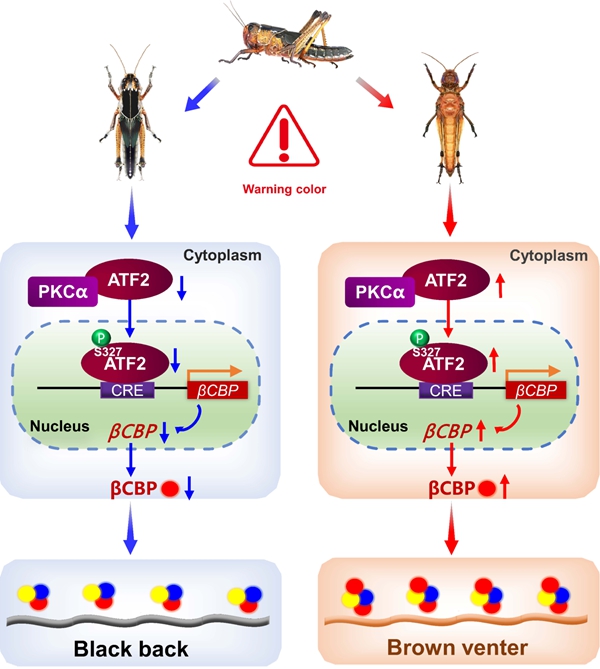The locusts we see are usually green. This coloration provides protection by allowing locusts to blend into their green surroundings to avoid predators. However, when locusts gather in high population densities and undergo transformation from a solitary to a gregarious phase, they cause severe plagues. With this transformation, their body color also changes dramatically from green all over to black backs and brown abdomens.
In a study published in Science Advances on Aug. 23, Dr. KANG Le’s team from the Institute of Zoology of the Chinese Academy of Sciences found a specific regulatory factor responsible for this unique coloration.
The variation in body color observed in locusts reflects their remarkable environmental adaptability. Similar to solitary locusts, many insects exhibit green body color through a combination of yellow and blue pigments. However, studies have found that black body color comes from melanin and ommochrome pigmentation.
Several years ago, KANG’s team demonstrated that the black color on the backs of locusts is not caused by typical melanin deposition. Instead, it comes from overlaying a red complex formed by β-carotene-binding protein (βCBP) and β-carotene on the green coloration of solitary locusts.
Gregarious locusts are brown on the venter and black on the back. Through proteomic analysis of black and brown integuments of gregarious locusts, the researchers found that βCBP plays a key role in the formation of the striking black-brown body coloration. The distribution of βCBP-β-carotene in brown integuments is significantly higher than in black integuments, and this difference in distribution contributes to black-brown body coloration.
In addition, phosphorylation of the bZIP transcription factor ATF2 at its serine site and its subsequent nuclear localization promotes the expression of βCBP.
Subsequent studies have shown that this regulatory mechanism is closely linked to locust population density. As population density increases, green solitary locusts transform into black-brown gregarious locusts. This transformation is controlled by an intrinsic regulatory process in which PKCα responds to population density by rapidly activating and phosphorylating ATF2 Ser327.
This promotes ATF2 entry into the nucleus, facilitates its binding to the βCBP promoter, and activates its transcription. The difference in ATF2 phosphorylation levels between the black and brown integuments of locusts accounts for the differing amounts of βCBP distributed on the back and the venter, ultimately resulting in the distinctive black back and brown venter of gregarious locusts.
The study of body color in locusts is of great biological importance. In gregarious locusts, the spatially distinct signaling mechanisms that regulate βCBP expression and ATF2 phosphorylation are critical for the composition of their black back and brown venter. βCBP acts as a brush coated with the pigment β-carotene to give the locusts a color that shifts from green to black as population density increases, while much higher levels of βCBP-β-carotene on the venter result in a brown color.
This study reveals the ability of organisms to achieve distinct body color patterns through precise control of pigment deposition and sheds light on the evolution of environmental adaptations in warning coloration and group-defensive survival strategies. Gregarious locusts use their black-brown warning coloration, which is associated with the odor phenylacetonitrile and the toxin hydrogen cyanide, to enhance aposematism by stimulating both the visual and olfactory senses. In addition to alerting predators, gregarious locusts can maintain large swarms by facilitating recognition of conspecifics through distinct body coloration.
A ubiquitous phenomenon in the insect world is the darkening of body coloration in proportion to population density. Uncovering this pattern offers a significant key to understanding how changes in population density can lead to changes in body coloration. In addition, this discovery has important practical implications for pest prediction and forecasting.

Spatially differential regulation of ATF2 phosphorylation and βCBP expression contribute to warning coloration of gregarious locusts (Image by Xinle KANG and Meiling YANG)
Link: https://doi.org/10.1126/sciadv.adi5168
Contact:
Le Kang
Distinguished Professor
Institute of Zoology Chinese Academy of Sciences,
Beijing Institutes of Life Science
Tel: 86-10-64807399
Email: lkang@ioz.ac.cn

